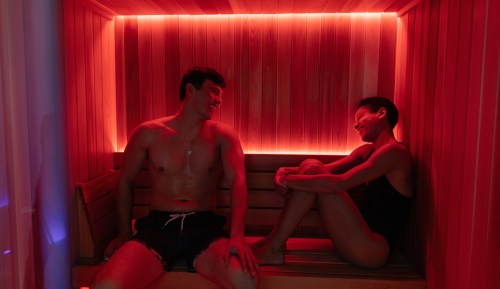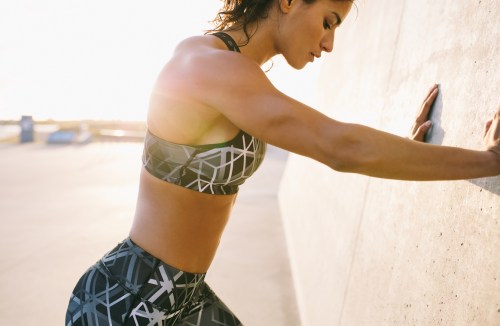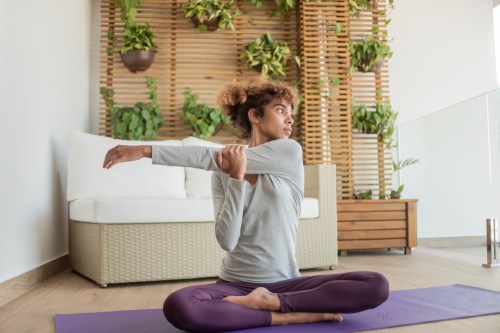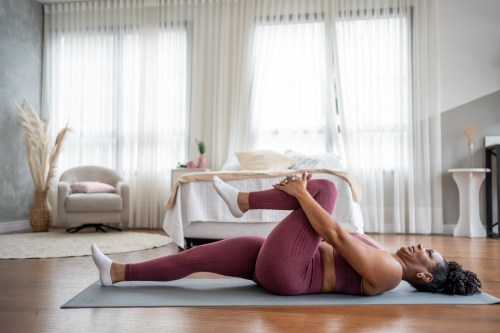Our editors independently select these products. Making a purchase through our links may earn Well+Good a commission
The 9 Best Full-Body Stretches That’ll Relax Every One of Your Muscles
Want every muscle in your body to feel totally relaxed? Try these full-body stretches, recommended by a physical therapist.
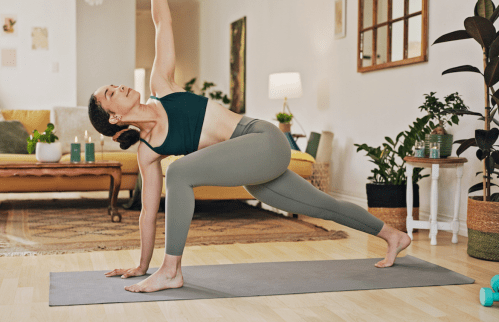
The value of stretching has likely been drilled into your brain over the years, but that knowledge doesn’t make it any less tempting to skip your post-workout cooldown moves or morning mobility flow. With so many work, social, and familial commitments, who has the time for a 15-plus-minute stretch routine, anyway?
Experts in This Article
board-certified sports specialist and physical therapist based in San Francisco
Your solution: Full-body stretches, moves that target multiple muscle groups at one time and, in turn, save the day when your schedule’s fully booked.
Why full-body stretches are important
To get scientific, stretching occurs when your brain and body work together to position your body in a way that creates a tensile or “pulling” force applied to a targeted muscle or group of muscles, says Leada Malek, DPT, SCS, CSCS, a physical therapist, board-certified sports clinical specialist, and the author of Science of Stretch.
With time and consistency, your body may adapt to this force, often improving flexibility and the joint range of motion allowed by the affected muscles. That means a regular full-body stretch routine will likely improve mobility, which, in turn, can positively affect daily functioning, Malek explains. The better mobility you have, the easier basic movement patterns like squatting, hinging, lunging, pushing, and pulling become.
“Other perks [of consistent stretching] include reduction in sedentary activity, improved neuromuscular control, positive effects on mental health, pain reduction, and things like possible improvements in sleep quality, nerve-related pain, and work-related pain (desk jobs),” she says.
Though stretching any part of your body is beneficial, it’s essential to take a holistic approach.
“Addressing the whole body can help address mobility in multiple regions, which can sometimes affect the area that feels restricted or present with ‘tightness,’” Malek says. “Plus, it just encourages movement in more areas of the body, which can be helpful for joint health.
Some full-body stretches also move your body through multiple planes of motion that you utilize in sports and everyday life—not just the sagittal plane (think: forward and backward), Malek says.
“In sports, multi-planar and multi-joint movement is a huge piece. Including a full-body stretch can help transfer into movements relevant for an activity (i.e., sprinting or playing tennis),” she adds. “For daily function, think of reaching to put something in a cabinet overhead, for example. Stretching your shoulder muscles can help, but including some rotation and extension in the spine and extension in the hips can encourage just that much more.”
The best full-body stretches out there
To nab those benefits, incorporate Malek’s favorite full-body stretches (also featured in her book) into your routine. Generally, you’ll want to hold each stretch for 15 to 60 seconds, completing one to three sets, she says. Alternatively, you can gently work in and out of the stretch for 10 to 15 reps (about 20 seconds), completing two sets.
Remember to maintain a relaxed breath and exhale through the holds, she suggests.
1. World’s greatest stretch
You can probably guess from the name: The world’s greatest stretch is one of the best full-body stretches you can practice. This move stretches your hips, ankles, and thoracic spine, Malek says.

- 1.Start in a high plank position with your feet hip-width apart and your shoulders stacked with your wrists.
- 2.Step your right foot forward and place it on the ground on the outside of your right hand.
- 3.Keeping your hips square, lift your right hand off the ground and drive it up toward the ceiling as far as comfortable, rotating your spine to the right at the same time. Allow your gaze to follow your fingertips.
- 4.To modify, bend your left leg and rest your knee on the ground.
- 5.Hold for 15 to 60 seconds.
- 6.Switch sides and repeat.
2. Scorpion
You’ll target your chest, spine, and hips with this full-body stretch, Malek says. The move does require control throughout your trunk, so remember to keep your core engaged to prevent your back from overarching, she advises.
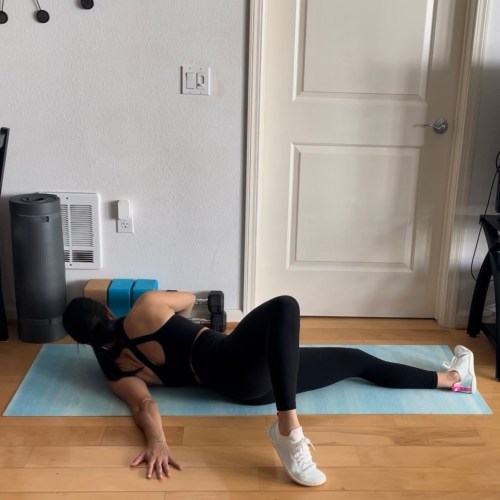
- 1.Lie face-down on the floor with your legs fully extended and toes tucked.
- 2.Extend your left arm out to the side at shoulder height and bend your right arm, with your palm flat on the floor next to your chest and your elbow tucked into your side.
- 3.Bend your right knee to a roughly 90-degree angle. Keeping your left arm extended and right knee bent, lift your right thigh off the ground.
- 4.Then, reach your right foot to the floor on the outside of your left leg, rotating through the spine. Use the bent arm to help control the speed and depth of the stretch. Gaze toward the right.
- 5.Hold for 15 to 60 seconds.
- 6.Switch sides and repeat.
3. Adductor thread the needle
This two-in-one stretch combines a classic thread the needle with an adductor stretch, targeting your spine, chest, and groin muscles and challenging hip flexibility, Malek says.
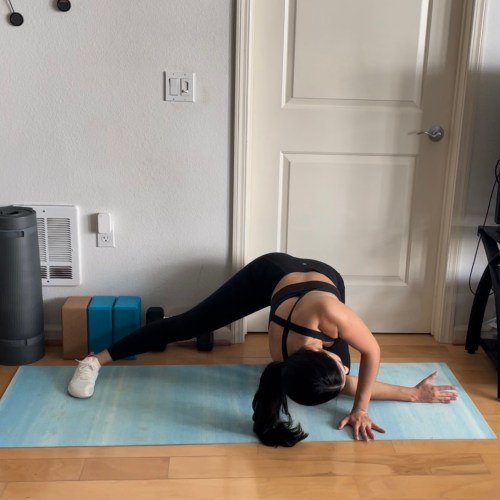
- 1.Start in a tabletop position on the floor with your hips stacked with your knees and your shoulders stacked with your hips. Gaze toward the floor slightly in front of you for a neutral neck.
- 2.Extend your right leg out to the side in line with your right hip, placing your right foot flat on the floor if your ankle mobility allows.
- 3.Rotating through your pine, reach your right arm underneath your trunk, between your left arm and left knee. Follow with your head and neck to encourage fluid movement throughout the spine. Maintain a straight back.
- 4.Pause, then reverse the movement. Pull your right arm back to the starting position, then immediately rotate through the spine to the right, driving your right arm up toward the ceiling. Allow your gaze to follow.
- 5.Slowly rotate back to center and lower your right hand back to the floor. That’s one rep.
- 6.Do 10 to 15 reps.
- 7.Switch sides and repeat.
4. Brettzel stretch
You might look like a pretzel while doing the Brettzel stretch, but fear not: You’ll target your quads and pecs while giving your spine some feel-good rotation, Malek says.

- 1.Lie on your right side with your legs stacked and your right arm resting on the floor in front of you at shoulder height.
- 2.Bend your left knee to a 90-degree angle in front of your body, parallel with your hips. Rest your left knee on the floor, then place your right hand on top of your knee.
- 3.Bend your right knee, bringing your right heel to your butt, then hold onto your right foot with your left hand. Keep your left palm facing up to encourage external shoulder rotation, which assists with the pec stretch.
- 4.Rotate through the spine to the left, bringing your left shoulder as close to the floor as possible. Hold this position.
- 5.Hold for 15 to 60 seconds.
- 6.Switch sides and repeat.
5. Adductor rock back
Spend some time performing the adductor rock back, and you’ll treat your stiff, inflexible hamstring and groin muscles to a much-needed stretch, Malek says.
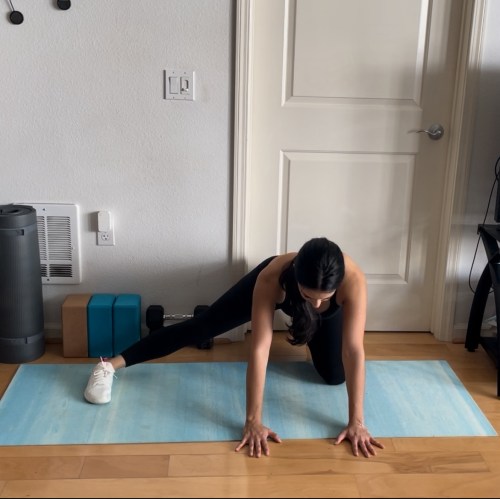
- 1.Start in a tabletop position on the floor with your hips stacked with your knees and your shoulders stacked with your hips. Gaze toward the floor slightly in front of you for a neutral neck.
- 2.Extend your right leg out to the side in line with your right hip, placing your right foot flat on the floor if your ankle mobility allows.
- 3.To more heavily target your groin muscles, keep your right foot pointed forward. To more heavily target your hamstrings, point your right foot toward the ceiling.
- 4.Slowly shift your hips back toward your left heel, then slowly rock forward until your shoulders are stacked with your wrists. That’s one rep.
- 5.Do 10 to 15 reps.
- 6.Switch sides and repeat.
6. Couch stretch
During a Love Is Blind commercial break, settle into a couch stretch, which improves hip flexor and quad flexibility, plus femoral nerve mobility, Malek says.

- 1.Start in a high-kneeling position in front of a couch or chair, with your hands on your hips, core engaged, and gaze forward.
- 2.Place your right foot flat on the floor in front of you, bending your knee to a 90-degree angle. Then, place the top of your left foot on top of the couch or chair.
- 3.Shift your weight forward into your right foot to stretch your left leg’s hip flexor and quad muscles.
- 4.Hold for 15 to 60 seconds.
- 5.Switch sides and repeat.
7. Wall thoracic extension stretch
This full-body stretch may look simple, but it shouldn’t be neglected. The exercise stretches your shoulders, lats, and core, improves hamstring flexibility, and extends your thoracic spine, Malek says.
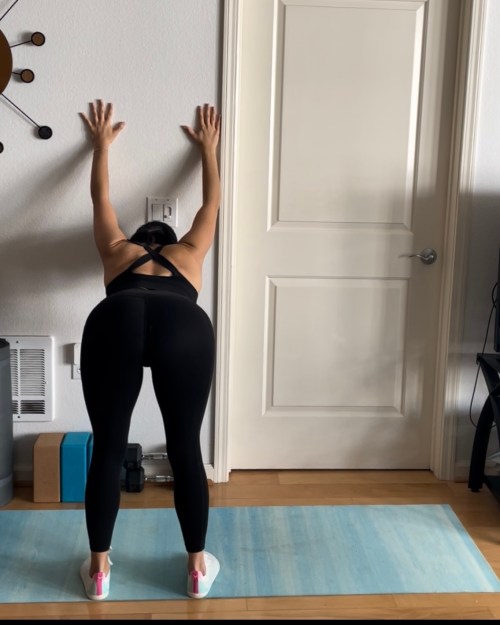
- 1.Stand in front of a wall with your feet shoulder-width apart, your hands pressed against the wall at shoulder height, and your gaze forward.
- 2.Take one step back so you’re leaning into the wall.
- 3.Keeping a slight bend in your knees, shift your hips back and allow your chest to sink toward the ground as far as is comfortable.
- 4.Hold for 15 to 60 seconds.
8. Doorway QL stretch
With the help of a door frame, this full-body stretch targets your lats, hips, and muscles along the side of your body, Malek says.
“Be mindful of any discomfort or pain in the back, shoulders, and arms, as this stretch requires movement at the lumbar spine which can be symptomatic for those with certain back pain,” she says.

- 1.Stand inside a doorway with your feet hip-width apart and arms at your sides.
- 2.Grip the door frame at shoulder height with your left hand.
- 3.Then, cross your left foot over your right and extend your right arm up toward the ceiling.
- 4.Shift your hips to the right, allowing your right arm to reach toward the door frame to stretch the side body.
- 5.Hold for 15 to 60 seconds.
- 6.Switch sides and repeat.
9. Modified pigeon pose
A classic yoga posture, modified pigeon pose targets your glutes, hip flexors, and low back, Malek says.
Pro tip: “Use your bottom knee to control how deep you load into the stretch in order to modify intensity,” she says.
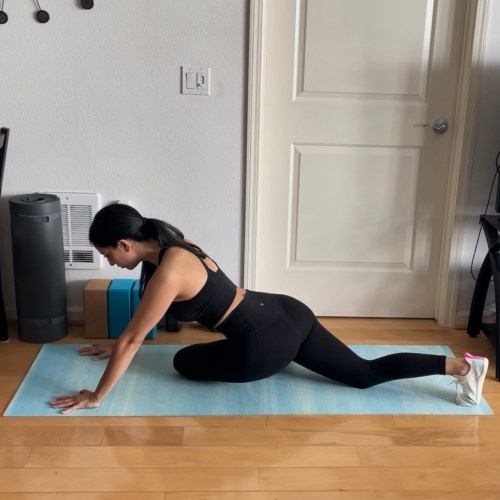
- 1.Start in a tabletop position on the floor with your hips stacked with your knees and your shoulders stacked with your hips. Gaze toward the floor slightly in front of you for a neutral neck.
- 2.Center your left knee so it’s aligned with your belly button.
- 3.Then, cross your right leg over your left, placing your right knee on the floor next to your left ankle. Keep your toes touching the ground.
- 4.Sink your hips back toward your left heel, allowing your right leg to fully extend behind you. Keep your hips square and your left glutes glued to the floor. Gaze toward the floor slightly in front of your hands.
- 5.Hold for 15 to 60 seconds.
- 6.Switch sides and repeat.
Sign Up for Our Daily Newsletter
Get all the latest in wellness, trends, food, fitness, beauty, and more delivered right to your inbox.
Got it, you've been added to our email list.
